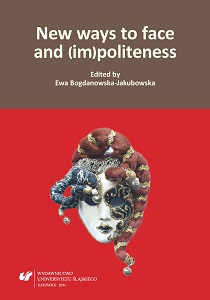Is the Italian figura just a facet of face? Comparative remarks on two socio-pragmatic key-concepts and their explanatory force for intercultural approaches
Is the Italian figura just a facet of face? Comparative remarks on two socio-pragmatic key-concepts and their explanatory force for intercultural approaches
Author(s): Gudrun Held
Subject(s): Language studies, Language and Literature Studies, Theoretical Linguistics, Applied Linguistics, Sociolinguistics
Published by: Wydawnictwo Uniwersytetu Śląskiego
Keywords: Italian; figura; face; intercultural
Summary/Abstract: The art of fare una bella figura is commonly considered as the cultural and societal cornerstone of the Italian way of life: covertly, but constantly regulating the Italian identity in its everyday interaction, it is not only an aesthetic and spirited show-off, but also a soulful and diplomatic manner of communication that makes foreigners surrender in feelings of admiration, envy or simple misunderstanding. I thus presume that the specific cultural concept of figura is a facet of the general concept of face as it is shaped in modern theories of pragmatics and cultural studies. While being pragmatically interrelated, the two concepts, nevertheless, reflect very different conceptualizations of the social image that they transport through history, discourse and literature. Overall, neither their communities, nor their differences have ever been studied systematically.As both, figura and face manifest themselves in the ongoing social performance, they are also a semiotic phenomenon that is mainly displayed in language use. Hence, the idiomatic expression “making a good or a bad figura” refers to verbal manners that can also be evaluated in terms of face-saving or face-losing. Therefore, I argue that “figuring” the figura in the right verbal way is nothing else than the Italian version of facework that is historically learned and culturally approved. Fare figura thus implies a range of strategies that are likely to keep up a context-appropriate “impression management” between felt solidarity and simulated equality.The present paper – part of a larger work in progress – takes up these theses. Intending to deepen both, affinities and differences of the two concepts, it is concerned with the following aims:
(1) a brief comparative study of the two notions taking into account their terminological history, their idiomatic collocations and their discursive development;
(2) an outline of the main socio-pragmatic concepts of face (and facework or face negotiation) in order to work out similarities and differences with the concept of figura;
(3) a discussion of these findings within the theory of (im)politeness (throughout the different stages of research where the traditional issue = first order politeness is distinguished from the scientific issue = second order politeness);
(4) a short evidence from selected data (namely Italian internet-blogs on the tragedy of Costa Concordia) where the figura-concept is emotionally discussed in terms of national stereotype. It is thus not only the main subject of the ongoing intercultural debate, but it also provokes a big variety of language strategies that visibly perform the bella or brutta figura in action.
Book: New ways to face and (im)politeness
- Page Range: 53-75
- Page Count: 23
- Publication Year: 2016
- Language: English
- Content File-PDF

